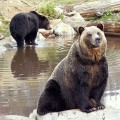Canada is a federated country in North America, made up of ten provinces and three territories. Canada is a vast nation with a wide variety of geological formations, climates, and ecological systems. It has rain forest, prairie grassland, deciduous forest, tundra, and wetlands. Canada has more lakes and inland waters than any other country. It is renowned for its scenery, which attracts millions of tourists each year. On a per-capita basis, its resource endowments are the second richest in the world after Australia.
Canada is the second largest country in the world but has about the same population as the state of California, which is one-25th its size. This is because the north of Canada, with its harsh Arctic and sub-Arctic climates, is sparsely inhabited. Most Canadians live in the southern part of the country. More than three-quarters of them live in metropolitan areas, the largest of which are Toronto, Ontario; Montréal, Québec; Vancouver, British Columbia; Ottawa, Ontario; Hull, Québec; and Edmonton, Alberta.
French and English are the official languages, and at one time most Canadians were of French or English descent. However, diversity increased with a wave of immigration in the late 19th and early 20th centuries that brought in peoples from many other European nations. This trend continues into the 21st century: Canada is one of the few countries in the world that still has significant immigration programs. Since the 1970s most immigrants have come from Asia, increasing the diversity of the population.
Canada's prosperity and diversity have encouraged a variety of artistic pursuits. Most major cities have symphony orchestras, opera companies, classical and modern dance groups, and live theater. Canadian popular musicians have built highly successful careers both in Canada and in the world at large. Canadian writers have also gained worldwide recognition, as have painters, sculptors, filmmakers, and architects. To nurture Canadian arts, the government has imposed quotas on foreign content in Canadian media.
Canada has impressive reserves of timber, minerals, and fresh water, and many of its industries are based on these resources. Many of its rivers have been harnessed for hydroelectric power, and it is self-sufficient in fossil fuel. Industrialization began in the 19th century and a significant manufacturing sector emerged, especially after World War II (1939 to 1945). Canada's resource and manufacturing industries export about one-third of their output. Transportation equipment is the leading manufacturing industry. While Canada's prosperity is built on the resource and manufacturing industries, most Canadians work in service occupations, including transportation, trade, finance, personal services, and government. Canada is a parliamentary democracy, and the federal, provincial, and territorial legislatures are all elected. Queen Elizabeth II of the United Kingdom is recognized as the queen of Canada. She is the official head of state. The queen is represented in Canada by the governor-general and ten lieutenant governors. Canada's constitution guarantees equality under the law to all of its citizens. Powers of the federal and provincial governments are spelled out separately under the constitution, but over the past 50 years they have increasingly cooperated in programs that provide a wide range of social services-often called the "welfare state"-to the public. Canada's indigenous peoples (original inhabitants) are often called First Nations or Indians. The name "Kanada" comes from a word meaning "village" or "community" in one of the indigenous Iroquois languages. Indigenous peoples had developed complex societies and intricate political relations before the first Europeans, the Vikings, arrived in the 11th century. The Vikings soon left, but more Europeans came in the 16th century and were made welcome because they brought manufactured goods and traded them for furs and other native products. However, the Europeans settled down and gradually displaced the indigenous peoples over the next 250 years. This process of dispossession has left a legacy of legal and moral issues that Canadians are beginning to face.
European settlers came in a series of waves. First were the French, followed by the English, and these two groups are considered the founding nations. France lost its part of the territory to Britain in a war in 1760, but most of the French-speaking colonists remained. Their effort to preserve their language and culture has been a continuing theme of Canadian history and has led in recent years to a movement to become independent of the rest of Canada.
Modern Canada was formed in an event that Canadians call Confederation, in 1867, when three colonies of Britain merged to create a partially independent state of four provinces. Since then, six more provinces and three territories have been added. Canada achieved full independence in 1931 but continues to belong to the Commonwealth of Nations, a voluntary association of countries with ties to the United Kingdom.

